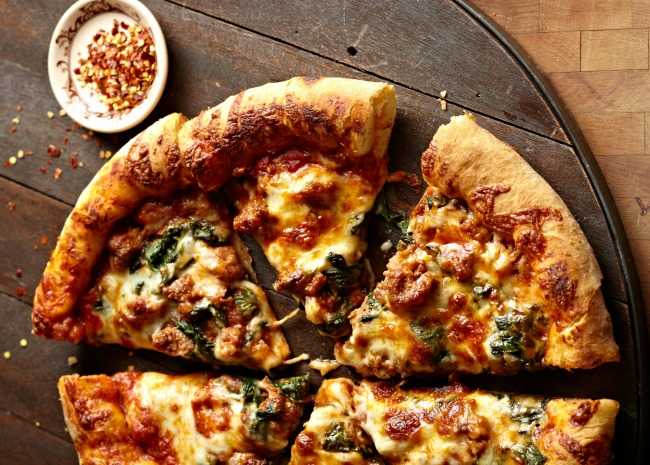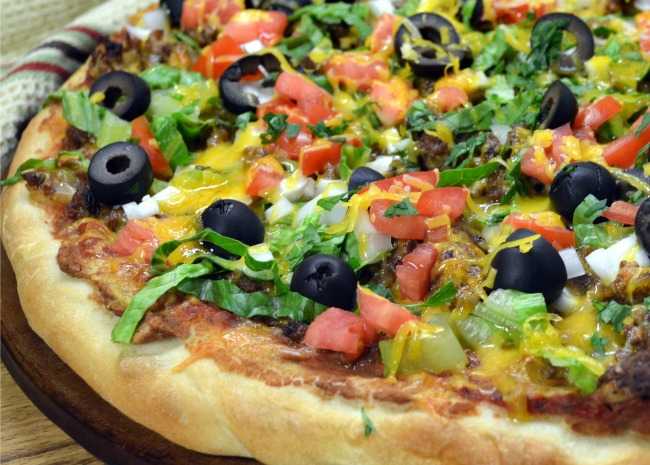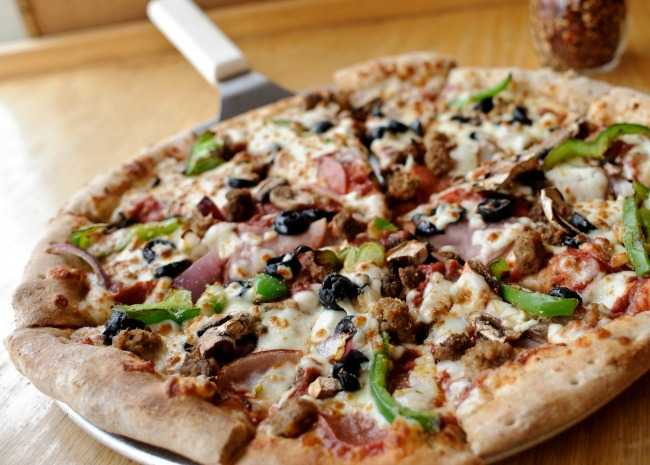There's almost no limit to the toppings you can pile on a pizza. Tomato sauce and pepperoni you know. But apples and walnuts? For sure. Fresh figs and prosciutto? Of course! Sweet corn and peas? Well, in Europe and Japan, corn and peas are common pizza toppings. Bottom line, pizza is open to an infinite amount of creativity where toppings are concerned.
We asked Matt Robinson of
Real Food by Dad for some of his
favorite pizza-topping combos:
Breakfast Pizza topped with crumbled bacon, diced red and green peppers, and fried eggs.
Chicken and Broccoli layered with pesto or with an alfredo sauce instead of the traditional red sauce.
Veggie Lovers is great as anything can go on it. Throw any odds and ends of veggies onto a bake sheet and roast them in the oven, then use Harissa for the base sauce. And to keep it simple, use a mix of mozzarella and Parmesan for the cheese.
Taco Pizza works great. It's such an economical choice, and the ingredients are always stocked in the pantry. For the sauce, it's usually a puree of black beans or refried beans, and then layers of traditional taco fixings.
Almost BLT Pizza. A variation on the classic sandwich using bacon, spinach and sundried tomatoes.
1. Generally, the hotter the oven, the better the pizza will be.
Place a pizza stone on a lower oven rack. Preheat the oven between 450 and 500 degrees F (250 to 260 degrees C) -- the stone needs heat up while the oven heats. Large, thick-crusted pizzas might need an oven temperature closer to 400 degrees F (200 degrees C) so the crust can cook completely before the toppings burn.
Pro Tip: For a crunchy crust, preheat a baking sheet or cast iron skillet in the bottom of the oven. Once you load the pizza, toss ice cubes into the hot pan to create a burst of steam.
2. Form the pizza dough and place it on a peel dusted with a little flour or cornmeal. If you like, lightly brush the crust with olive oil. This helps create a golden brown, crispy crust rather than a dry, dusty outer crust.
See how to make and form your pizza dough.
Okay, the oven is hot and the pizza's all topped and ready to roll.
3. Now let's slip it onto the hot pizza stone.
But first, jiggle the peel to make sure the pizza isn't sticking. You want it to slide off the peel easily. If it's stuck, gently lift the sticky dough and dust with a wee bit more flour or cornmeal.
Place the tip of the peel on the edge of the stone at the back of the oven. With one swift motion, jerk the peel back out from under the pizza. If the pizza slides freely on the peel, it should land perfectly in the middle of the pizza stone. If the pizza sticks to the peel, your toppings will slide off the pizza onto the stone, and the kids will hear you say those words you're not really supposed to use in front of them.
Close the oven door and let the pizza bake.
4. After 5 minutes of baking, check the pizza. If some spots are browning faster than others, turn the pizza; slip the peel underneath it like a giant spatula. Rotate the pizza on the peel and return it to the baking stone using the same swift motion described above.
If you like, remove the pizza from the oven halfway during baking to brush more oil on the crust. This added oil will help darken the crust and make it even tastier. For a little garlic flavor, infuse the oil with minced garlic.
5. The pizza is done when the cheese is melted to a medium-to-dark brown -- color means flavor. Carefully remove the pizza with the peel and let it cool slightly. If you want, top it with additional fresh toppings. Slice with a pizza wheel or chef's knife, and serve to your adoring crowd.
Feel the Burn: When pizza scalds the roof of your mouth, don't blame the cheese. Most likely, it's the sauce. That's because heat is conserved in the wet sauce, and an insulating layer of cheese is very likely adding insult to injury. Next time you get a slice fresh from the oven, lift the heat-trapping lid of cheese with a fork, and you'll see how the steam pours off the hot, hot sauce. It's like the molten core of the earth in there.



No comments:
Post a Comment